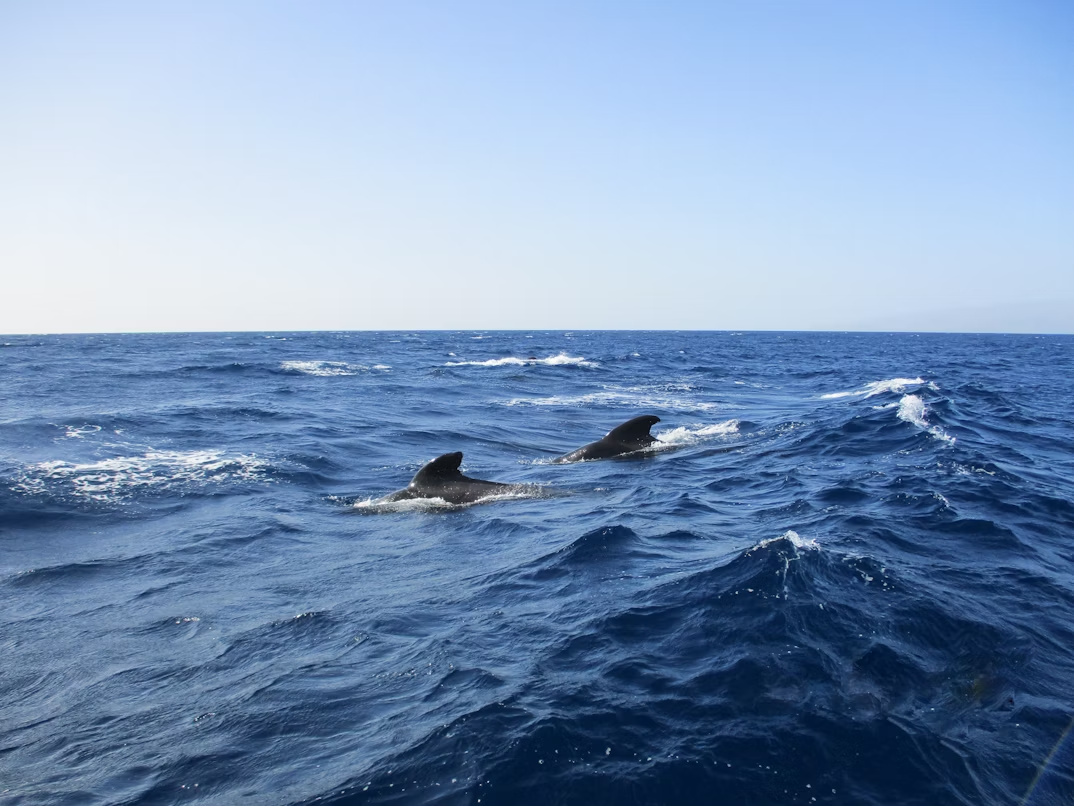Overview: Beyond Intuition
For many years, instinct—a collection of innate, genetic guidelines for survival—was the primary framework used to explain animal behaviour. A far more complicated reality in the oceans is being revealed by a groundbreaking body of research, though, as many whales and dolphins have highly developed cultures. These are customs that are specific to particular groups and are taught, shared, and transmitted from one generation to the next; they are not merely basic behaviours.
The most striking example of this cultural transmission can be seen in the various and creative hunting strategies that various pods have evolved. These behaviours, which range from dolphins using marine sponges as tools to orcas carefully beaching themselves to snatch seals, are not encoded in DNA. Elders teach them to the younger generation, and they define a pod’s identity just as clearly as any regional human custom does a community. This 2,500-word analysis delves deeply into the fascinating realm of cetacean culture, examining the origins, maintenance, and conservation importance of these marine traditions.
1. The Foundations of Cetacean Culture: What Constitutes a Tradition?
A behaviour must fulfil certain requirements that set it apart from instinct in order to be classified as cultural.
- It is Learnt: Rather than being inherited, the behaviour is learnt via practice, imitation, and observation.
- It spreads both vertically from one generation to the next and horizontally among peers.
- It is Group-Specific: Despite having similar environments and genetic makeup, some groups within the same species practise it while others do not.
- It is Persistent: It lasts longer than the person who created it.
Case Studies: An Entire Universe of Varying Hunting Customs .
The best evidence for culture comes from differences in hunting strategies among pods of the same species
A. Killer Whales: The Experts in Their Field
Orca ecotypes have split off into cultural groups, each of which teaches its young different hunting techniques and diets.
B. Bottlenose Dolphins: The Mud-Ringers and Tool Users:
Sponging in Australia’s Shark Bay:
- The method: When foraging on the seafloor, some female dolphins break off a marine sponge and wear it over their rostrum (beak) like a protective glove. They are shielded from stinging animals and jagged rocks by the sponge.
- The Culture: This behaviour is a striking example of a matrilineal cultural tradition, as it is almost exclusively passed down from mothers to their daughters. Dolphins in other regions do not do this; it is not instinctive.
Florida, USA Mud-Ring Feeding:
- The Method: A “ring maker” dolphin whips up a plume of mud that creates a makeshift net around a school of fish while swimming in a tight circle close to the seabed.
- The Culture: The pod’s other dolphins assemble around the ring after recognising the signal. The fish, trapped by the muddy curtain, leap out of the water—and straight into the waiting mouths of the dolphins. Young dolphins learn this intricate cooperative technique through participation, which is a local tradition.
C. Humpback Whales: The Creative Bubble-Netters
- The Method: A team of humpbacks hunts together. A school of fish or krill are concentrated into a dense mass when one or more whales blow a spiral net of bubbles around them. The entire group of whales then surges through the bubble net with their mouths open after other whales vocalise to push the prey upward.
- The Culture: Although bubble-net feeding is recognised in a number of populations, each group uses distinct vocalisations and patterns. One particular invention in the last few decades—”tail-slapping” to reinforce the bubble net—was created by a single whale in the Gulf of Maine and quickly spread to more than 100 others through social learning, illustrating the emergence and spread of new cultural traits.
3. The “How”: Cultural Transmission Mechanisms
In cetaceans, teaching is a social, active, and patient process.
- By pushing her calf onto the beach and then retrieving it, the mother is actively promoting her calf’s learning in the context of orca stranding, rather than merely engaging in the behaviour. For the benefit of the student, this necessitates a cost (risk, energy) to the teacher.
- In scaffolded learning, young dolphins and whales first observe before practicing parts of a complex behaviour (for example, a young dolphin may practise creating a small mud cloud before learning the entire ring). This trial-and-error process is supported by the pod.
- Social Reinforcement: The entire pod supports successful hunts. The young are encouraged to keep learning and using the pod’s special techniques because of the mutual success, which also fortifies social ties.
4. The Need for Conservation: Preserving Cultural Heritage
Conservation is significantly impacted by the recognition of cetacean culture. We are now safeguarding distinct cultural entities rather than merely a species.
- The Danger of Cultural Erosion: Even if the physical environment is preserved, a pod of salmon-specialist orcas may no longer be able to successfully hunt its traditional prey if its matriarchs, who serve as the archives of cultural knowledge, are lost.
- Impact of Noise Pollution: Sophisticated hunts, such as bubble-netting, are coordinated by complex vocalisations. Seismic surveys and shipping noise can interfere with this communication, thereby “jamming” the cultural transmission and resulting in starvation and unsuccessful hunts.
- A New Legal and Ethical Framework: According to some scientists, pods with unique cultural characteristics ought to be given extra protection. Only a small number of orcas use the Patagonian stranding technique, which could be permanently lost if a single pod is lost.
In conclusion, a water mirror
- The old hierarchy that put humans at the top is upended by the discovery that whales and dolphins have culture. It shows a world where identity is defined by traditions, grandmothers are repositories of survival knowledge, and a group’s ability to survive depends on its ability to successfully apply acquired skills.
- Our responsibility grows as we continue to disentangle these intricate social tapestries. Today, preserving these creatures means preserving not only their lives but also their way of life—the distinctive cultures that have developed over thousands of years in the ocean’s enormous, deep classrooms.
FAQ
Yes, it is culture according to the scientific definition applied to animals. These behaviours are specific to particular groups, persistently passed down through generations, and learnt rather than innate. This satisfies every requirement for what biologists and anthropologists consider to be culture.
They see completely different behaviours from the same species in nearby locations with the same genetic makeup and surroundings. Only some dolphin families in Shark Bay, for instance, “sponge,” while their close neighbours do not, even though they have access to the same sponges and prey. This eliminates the possibility of a genetic or only environmental cause.
It alters how we interact with nature. It compels us to view whales and dolphins as unique individuals with unique histories and customs rather than as nameless members of a species. As a result, there may be a greater need to conserve them and a greater sense of empathy.
No, but their non-human cultures are among the most intricate and well-researched. Cultural behaviours are also demonstrated by other animals, including chimpanzees (with their tool-use customs), some bird species (with regional song dialects), and even some fish. Nonetheless, it is especially remarkable how diverse and intricate cetacean cultures are.

